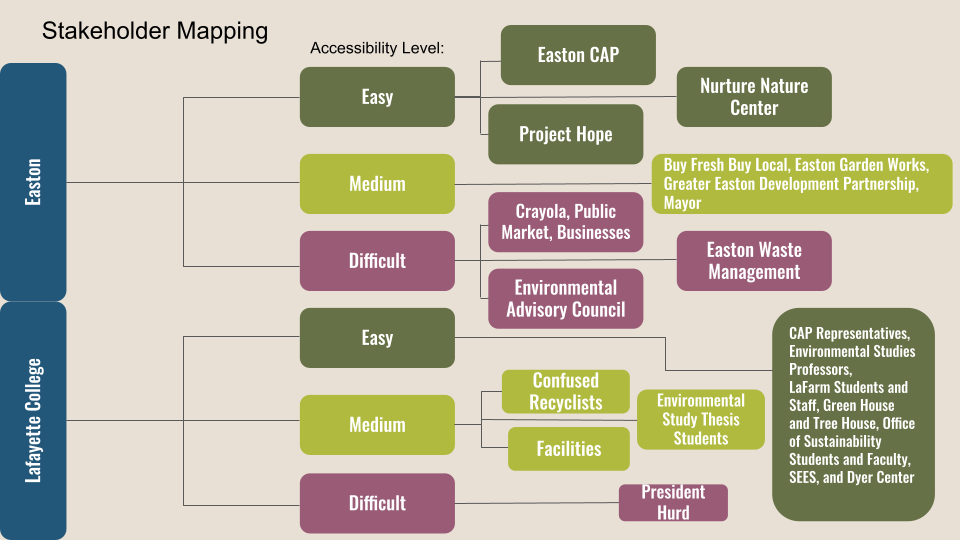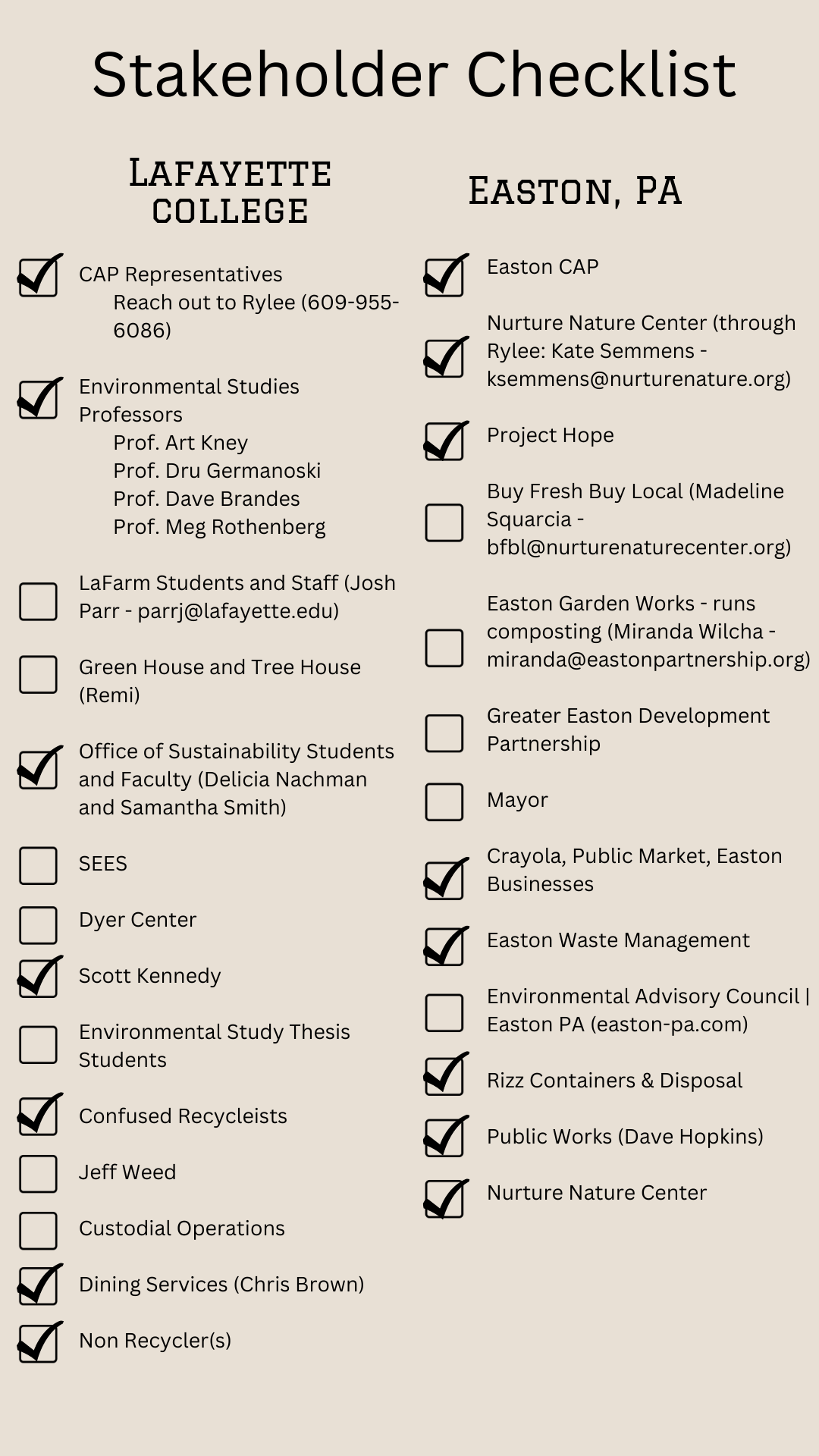In order to determine stakeholders who were relevant within the sphere of our problem area, our team listed all the stakeholders we could think of individually. Once they were all listed, we agreed to focus on stakeholders that were more accessible to our group by prioritizing input from organizations and people who are in and around Easton and Lafayette College. We then reorganized these stakeholders into categories based on how easy it would be for us to get in contact with them. In the diagram below, you can see the how we grouped different stakeholders together in terms of ease of accessibility, denoted by the colors.

Stakeholder Assumptions:
When selecting stakeholders, our group made various assumptions about the people and organizations we were focusing on. One of which was that everyone cares about this issue as much as we do. Another is that people are willing to be incentivized.
Not everyone will be as open to using correct sustainable methods in place of harmful habits. For example when the only recycling available is down the hall, it is easy just to throw the item away in the trash. If the trash can is full, it is easier to just throw that trash into the recycling. Convenience sometimes holds a higher value than correctness. Our team has noticed this problem around campus, especially in locations like Gilbert’s Cafe. Even though it costs more to recycle per ton than to send waste to the landfill (1), some people still throw items into recycling that do not belong there. The high cost of recycling means that addressing proper procedures should be something that is wanted by the group paying for the recycling. This higher cost could be one example of an incentive or reason to break old habits.
Additionally, we recognize that it is possible that none of those groups of stakeholders will agree that the change is worth it. However, past strategies have even used more overt incentivisation to combat this and to promote sustainable practices. Examples include legislative and non-legislative intervention methods such as disposal fees, green designs, and general education, with a bottom-up focus on behavior change (2). These examples can help us make more people use our product to care for the world and follow proper recycling procedures even if they do not care as much.
Stakeholder Interview Takeaways:
After speaking to some of our stakeholders, including Scott Kennedy with facilities and Samantha Smith with the Office of Sustainability, we learned that many users in our market segment do not know about the requirements for recycling and the overall waste management process. Specifically, it is not as common to know how to dispose of plastics properly so that the items in the recycling container do not become contaminated to the extent where they end up getting thrown away.
We also learned that this happens to contaminated batches of recycling during an interview with Rylee Bordwick. According to Scott, the recycling plant used by Lafayette can take up to 10% waste contamination in recycling. Dave Hopkins provided more insight into what can contribute to the contamination of recyclable materials with Easton Public Works. Examples include food, liquids, and things like shredded paper. Without this knowledge, users are inadvertently contributing to the allocation of waste at Lafayette by disposing of plastics and other recyclable materials in the wrong locations.
Another thing we realized was that the inconvenient placement of waste and recycling bins has reduced users’ motivation to continue recycling. Recycling bins on campus are in areas that students find to be too far from where they are, so the long walking distances discourage them from active recycling. In interviews, some of our stakeholders also pointed out that users don’t feel a sense of urgency about the matter. While the negative impact of waste pollution is severe, users refrain from recycling because they do not believe that recycling makes a difference. The most important ways to combat these problems are to teach users about more effective recycling methods, to reward them for engaging in activities that promote recycling, and to emphasize the importance of waste management and sustainability. We will aim to offer educational resources about where their recycled materials end up in the final stage of the recycling process to solve the dilemma of inadequate education about recycling.
Since our last deliverable, we met with Sam Smith from the Office of Sustainability for a second time, Scott Kennedy from Facilities Operations for a second time, and Chris Brown from Dining Services. We spoke with them to determine the specific processes used by each of their fields to mitigate contamination in recycling bins, and to find which issues remained prominent in the recycling space.
Sam Smith told us more about the waste auditing process at Lafayette College. She revealed details about the guidelines that the office of sustainability has for what they considered waste and what they considered recycling. Sam also shared crucial waste auditing data with us that provided the total waste and recycling they collected each year by tonnage. After talking with Sam, she gave us the contact information for Jeff Weed, the Supervisor of Grounds, and Scott Kennedy, the director of Facilities Operations. We then met with Scott Kennedy again to learn about contamination issues since he has experience in coordinating and leading all facilities operations regarding recycling and waste management on campus. He provided us with insight into how the custodians manage trash and recycling throughout campus and when they do it. Scott told us that the biggest issues regarding contamination of recycling bins were liquid waste and that the Facilities Operations needs help to determine a way of disposing of liquids and reducing their contamination.
The most recent meeting we had was with Chris Brown, the general manager of dining services at Lafayette College. He commented that the main issues that contribute to why to-go food places are not implementing reusable containers is the lack of infrastructure, which is the ability to wash, dry and restore the containers for reuse. Chris also mentioned that there is a spillover of single use plastic utensils from COVID-19 and that dining services are working towards depleting these by the end of the year.
As we continue the project, we will continue to reach out to stakeholders and to keep them updated to our progress.

